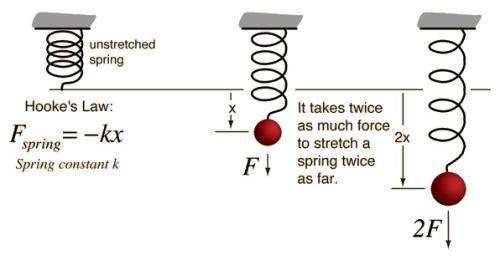
Physics, 23.10.2019 06:00 desiree3114
In hooke's law, f spring = k (triangle) x , what does the k stand for?
a. the amount of force acting on the spring
b. the elastic constant, a number that tells the relative strength of the spring
c. the distance the spring stretches
d. the constant of gravity

Answers: 3


Another question on Physics

Physics, 22.06.2019 00:00
What should the power status of a circuit be when measuring resistance with an ohmmeter?
Answers: 2

Physics, 22.06.2019 06:00
Aball is thrown upward. at a height of 10 meters above the ground, the ball has a potential energy of 50 joules (with the potential energy equal to zero at ground level) and is moving upward with a kinetic energy of 50 joules. what is the maximum height h reached by the ball? consider air friction to be negligible. 1. h ≈ 10 m 2. h ≈ 50 m 3. h ≈ 30 m 4. h ≈ 40 m 5. h ≈ 20 m 003 10.0 points which of the two object shown below has the greatest kinetic energy? a m b 1 2 m v 2v 1. kinetic energies are the same. 2. a 3. b 4. unable to determine. 004 10.0 points tim, with mass 74.6 kg, climbs a gymnasium rope a distance of 3.1 m. the acceleration of gravity is 9.8 m/s 2 . how much potential energy does tim gain? answer in units of j. 005 10.0 points a car is moving at 64 miles per hour. the kinetic energy of that car is 5 × 105 j. how much energy does the same car have when it moves at 111 miles per hour? answer in units of j. 006 10.0 points an 102 kg man climbs up a 1 m high flight of stairs. the acceleration of gravity is 9.81 m/s 2 . w
Answers: 3

Physics, 22.06.2019 08:30
What is the primary force that suspension bridges use cables to hold their spans up? a. tension force b. resistance force c. normal force d. elastic force e. applied force
Answers: 3

Physics, 22.06.2019 11:20
The ultracentrifuge is an important tool for separating and analyzing proteins. because of the enormous centripetal accelerations, the centrifuge must be carefully balanced, with each sample matched by a sample of identical mass on the opposite side. any difference in the masses of opposing samples creates a net force on the shaft of the rotor, potentially leading to a catastrophic failure of the apparatus. suppose a scientist makes a slight error in sample preparation and one sample has a mass 10 mg larger than the opposing sample. if the samples are 12 cm from the axis of the rotor and the ultracentrifuge spins at 70,000 rpm, what is the magnitude of the net force on the rotor due to the unbalanced samples? ( be thorough on your answer)
Answers: 3
You know the right answer?
In hooke's law, f spring = k (triangle) x , what does the k stand for?
a. the amount of...
a. the amount of...
Questions








Computers and Technology, 27.05.2021 23:40



Computers and Technology, 27.05.2021 23:40





Mathematics, 27.05.2021 23:40


Mathematics, 27.05.2021 23:40

History, 27.05.2021 23:40





